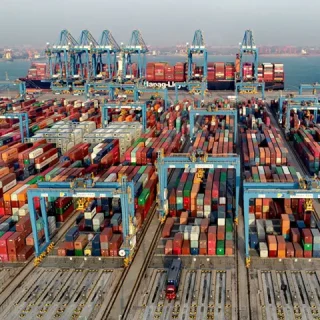China’s renminbi (RMB) has been growing in prominence, specifically in the country’s own cross-border transactions, marking a significant shift in global finance. However, its usage on a global scale remains limited compared to the size of China’s GDP and influence in trade.
According to China’s State Administration of Foreign Exchange (SAFE), in March, the renminbi surpassed the U.S. dollar for the first time in China’s cross-border payments, accounting for 47% of such settlements in 2021. This is nearly double the share from five years earlier, with foreign trading of renminbi assets being a key factor. However, on a global scale, the renminbi’s market share remains modest at 2.5%, up from 1.1% at the end of 2013, according to Goldman Sachs Research.
The increase in the renminbi’s market share marks progress in its role as a “medium of exchange” in global markets, yet the advancement appears slow in other aspects. Capital controls and the currency’s not being freely tradable hamper its progression as a “store of value” and “unit of account.” Despite China’s growing importance in global markets, the U.S. dollar still dominates international payments, accounting for 43% as of May 2023.
In contrast, the renminbi’s uptake in China’s cross-border transactions has been swift, mainly due to more foreign trading of renminbi-denominated securities. Since 2018, China’s A-shares and onshore bonds’ inclusion in major global equity and bond indexes have contributed to higher cross-border payments related to portfolio investment. Renminbi-settled trade grew to 19.8% by Q3 of 2022, up 5.8 percentage points from a decade ago.
Earlier this year, Brazil and Argentina announced renminbi settlements in trading with China, signifying potential growth in renminbi’s international usage. However, constraints remain due to China’s capital controls and limited offshore liquidity in the currency. The People’s Bank of China has taken measures like extending bilateral swap lines to promote renminbi usage in trade settlements.
China’s currency remains scarcely used as a store of value. International bond markets only account for around 0.7% of renminbi-denominated securities, with reserves denominated in China’s currency representing just 3% of global reserves. Offshore renminbi loans and deposits in 2021 only made up around 0.5% of the total onshore figures, compared to over 25% for the U.S. dollar and close to 20% for the euro.
Hong Kong’s role as the offshore centre for renminbi offers a variety of investment options for global investors, including bonds, ETFs, equities, and more. Geopolitical uncertainties might push the internationalisation of China’s currency, but the unfavourable interest rate spread could deter investors from holding more renminbi assets.










